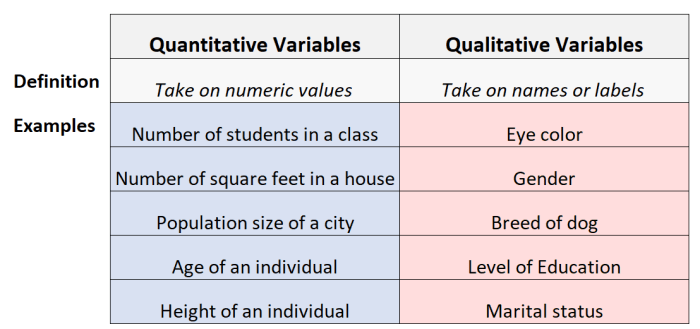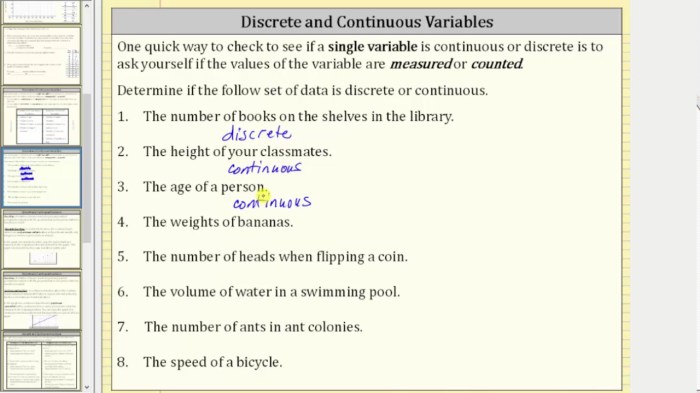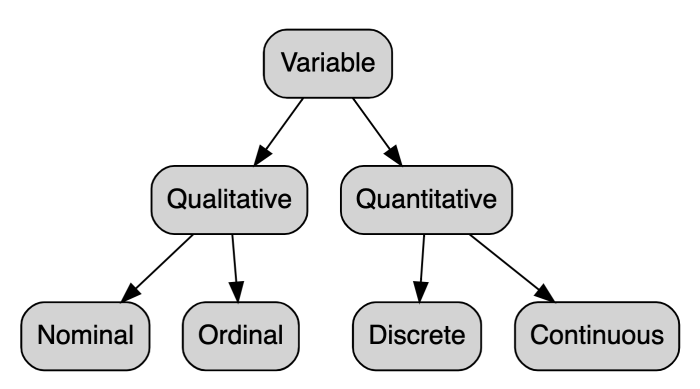Determine whether each variable is qualitative continuous or discrete – In the realm of data analysis, understanding the nature of variables is paramount. This guide delves into the concepts of qualitative, continuous, and discrete variables, empowering you to accurately determine their type and harness their potential for meaningful insights.
By exploring the nuances of ordinal and nominal scales, scatterplots, and histograms, you will gain a deep understanding of how to classify variables effectively. This knowledge will not only enhance your statistical prowess but also ensure the integrity and accuracy of your data analysis.
Determine Whether Each Variable is Qualitative Continuous or Discrete

Introduction, Determine whether each variable is qualitative continuous or discrete
In statistics, variables are classified into three types based on their characteristics: qualitative, continuous, and discrete. Understanding the type of variable is crucial for selecting appropriate statistical tests and interpreting data accurately.
Qualitative variablesare non-numeric and represent categories or groups. They cannot be ordered or ranked. Examples include gender, eye color, and occupation.
Continuous variablesare numeric and can take any value within a specified range. They can be measured to any level of precision and are often represented on a number line. Examples include height, weight, and temperature.
Discrete variablesare numeric but can only take specific, whole number values. They cannot be divided into smaller units. Examples include the number of siblings, the number of cars in a household, and the number of days in a month.
Methods for Determining Variable Type
Ordinal and Nominal Scales
Qualitative variables can be further classified into ordinal and nominal scales.
- Ordinal scaleshave categories that can be ranked or ordered. Examples include income levels (low, medium, high) and education levels (elementary, high school, college).
- Nominal scaleshave categories that cannot be ranked or ordered. Examples include gender (male, female) and blood type (A, B, AB, O).
Scatterplots and Histograms
To determine if a continuous or discrete variable is present, we can use scatterplots and histograms:
- Scatterplotsshow the relationship between two variables. If the points form a smooth line, the variable is continuous. If the points form distinct clusters, the variable is discrete.
- Histogramsshow the distribution of a variable. If the bars are continuous and form a bell-shaped curve, the variable is continuous. If the bars are separated and form distinct categories, the variable is discrete.
Examples of Variable Types
| Qualitative | Continuous | Discrete | Description |
|---|---|---|---|
| Gender | Height | Number of children | Non-numeric categories |
| Occupation | Weight | Age | Numeric values with any precision |
| Education level | Temperature | Number of siblings | Numeric values only in whole numbers |
Applications of Variable Type Determination
Correctly identifying variable type is essential for data analysis. It influences:
- Choice of statistical tests:Different statistical tests are appropriate for different variable types. For example, t-tests are used for continuous variables, while chi-square tests are used for qualitative variables.
- Interpretation of results:The meaning of statistical results depends on the type of variable. For example, a mean value for a continuous variable represents an average, while a mode value for a qualitative variable represents the most common category.
Essential Questionnaire
What is the difference between a qualitative and a quantitative variable?
Qualitative variables describe attributes or characteristics that cannot be measured numerically, while quantitative variables represent numerical values that can be measured and analyzed mathematically.
How can I determine if a variable is continuous or discrete?
Continuous variables can take on any value within a specified range, while discrete variables can only take on specific, distinct values.
Why is it important to correctly identify variable types?
Correctly identifying variable types ensures that you select the appropriate statistical tests and analysis methods, leading to accurate and reliable conclusions.


